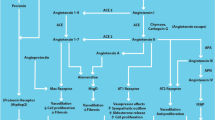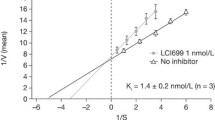Abstract
A dysregulation of the aldosterone system has been involved in the pathophysiology of cardiovascular diseases, including myocardial failure and, partially, essential hypertension. In humans and in rat models, aldosterone action induces heart remodeling and interstitial and perivascular myocardial fibrosis. Therefore, a rationale for using aldosterone antagonists (ARAs) of the spironolactone family, which have been available for decades for the treatment of aldosterone excess syndromes, has now emerged. The development of compounds such as eplerenone, with a greater selectivity for mineralocorticoid receptors, is promising also in terms of reduction of endocrine side effects. The use of ARAs for the treatment of myocardial failure and selected cases of hypertension, in combination with the current therapy, has been strongly supported by trials such as the Randomized Aldactone Evaluation Study (RALES) and the Eplerenone Neurohormonal Efficacy and Survival Study (EPHESUS). Thus, the addition of ARAs to the conventional therapy appears beneficial, leading to an improved survival rate and a reduced incidence of cardiac complications.
Similar content being viewed by others
References and Recommended Reading
Jeunemaitre X, Kreft-Jais C, Chatellier G, et al.: Long-term experience of spironolactone in essential hypertension. Kidney Int Suppl 1988, 26:S14-S17.
Glorioso N, Tonolo G, Troffa C, et al.: Recognition of markers of response to potassium-canrenoate in essential hypertension. Steroids 1995, 60:105–109.
Campbell SE, Diaz-Arias AA, Weber KT: Fibrosis of the human heart and systemic organs in adrenal adenoma. Blood Press 1992, 1:149–156.
Young MJ, Funder JW: The renin-angiotensin-aldosterone system in experimental mineralocorticoid-salt-induced cardiac fibrosis. Am J Physiol 1996, 271:E883-E888.
Swedberg K, Eneroth P, Kjekshus J, Wilhelmsen L: Hormones regulating cardiovascular function in patients with severe congestive heart failure and their relation to mortality. CONSENSUS Trial Study Group. Circulation 1990, 82:1730–1736.
Duprez DA, Bauwens FR, De Buyzere ML, et al.: Influence of arterial blood pressure and aldosterone on left ventricular hypertrophy in moderate essential hypertension. Am J Cardiol 1993, 71:17A-20A.
Pitt B, Zannad F, Remme WJ, et al.: The effect of spironolactone on morbidity and mortality in patients with severe heart failure. Randomized Aldactone Evaluation Study Investigators. N Engl J Med 1999, 341:709–717.
Pitt B, Williams G, Remme W, et al.: The EPHESUS trial: eplerenone in patients with heart failure due to systolic dysfunction complicating acute myocardial infarction. Eplerenone Post-AMI Heart Failure Efficacy and Survival Study. Cardiovasc Drugs Ther 2001, 15:79–87.
Pitt B, Remme W, Zannad F, et al.: Eplerenone, a selective aldosterone blocker, in patients with left ventricular dysfunction after myocardial infarction. N Engl J Med 2003, 348:1309–1321. One of the reports on the important EPHESUS study, showing the advantage of the addition of eplerenone to current cardiovascular therapy in MI and HF.
Tan LB, Schlosshan D, Barker D: Fiftieth anniversary of aldosterone: from discovery to cardiovascular therapy. Int J Cardiol 2004, 96:321–333. An updated and comprehensive review on the role of aldosterone and ARAs in cardiovascular diseases.
Silvestre JS, Robert V, Heymes C, et al.: Myocardial production of aldosterone and corticosterone in the rat: physiological regulation. J Biol Chem 1998, 273:4883–4891.
Struthers AD: Evidence for myocardial synthesis of aldosterone producing myocardial fibrosis in man. Clin Sci (Lond) 2002, 102:387.
Hatakeyama H, Miyamori I, Fujita T, et al.: Vascular aldosterone: biosynthesis and a link to angiotensin II-induced hypertrophy of vascular smooth muscle cells. J Biol Chem 1994, 269:24316–24320.
Arriza JL, Weinberger C, Cerelli G, et al.: Cloning of human mineralocorticoid receptor complementary DNA: structural and functional kinship with the glucocorticoid receptor. Science 1987, 237:268–275.
Lombes M, Farman N, Bonvalet JP, Zennaro MC: Identification and role of aldosterone receptors in the cardiovascular system. Ann Endocrinol (Paris) 2000, 61:41–46.
Kellendonk C, Gass P, Kretz O, et al. Corticosteroid receptors in the brain: gene targeting studies. Brain Res Bull 2002, 57:73–83.
Christ M, Sippel K, Eisen C, Wehling M: Non-classical receptors for aldosterone in plasma membranes from pig kidneys. Mol Cell Endocrinol 1994, 99:R31-R34.
Kagawa CM, Cella JA, Van Arman CG: Action of new steroids in blocking effects of aldosterone and deoxycorticosterone on salt. Science 1957, 126:1015–1016.
Fanestil DD: Mechanism of action of aldosterone blockers. Semin Nephrol 1988, 8:249–263.
Armanini D, Karbowiak I, Goi A, et al.: In-vivo metabolites of spironolactone and potassium canrenoate: determination of potential anti-androgenic activity by a mouse kidney cytosol receptor assay. Clin Endocrinol (Oxf) 1985, 23:341–347.
Dupont A: Disappearance of spironolactone-induced gynaecomastia during treatment with potassium canrenoate. Lancet 1985, 2:731.
McMahon EG: Recent studies with eplerenone, a novel selective aldosterone receptor antagonist. Curr Opin Pharmacol 2001, 1:190–196.
de Gasparo M, Joss U, Ramjoue HP, et al.: Three new epoxyspirolactone derivatives: characterization in vivo and in vitro. J Pharmacol Exp Ther 1987, 240:650–656.
de Gasparo M, Whitebread SE, Preiswerk G, et al.: Antialdosterones: incidence and prevention of sexual side effects. J Steroid Biochem 1989, 32:223–227.
Mantero F, Lucarelli G: Aldosterone antagonists in hypertension and heart failure. Ann Endocrinol (Paris) 2000, 61:52–60.
Mantero F, Opocher G, Rocco S, et al.: Long-term treatment of mineralocorticoid excess syndromes. Steroids 1995, 60:81–86.
Staessen J, Lijnen P, Fagard R, et al.: Rise in plasma concentration of aldosterone during long-term angiotensin II suppression. J Endocrinol 1981, 91:457–465.
McKelvie RS, Yusuf S, Pericak D, et al.: Comparison of candesartan, enalapril, and their combination in congestive heart failure: randomized evaluation of strategies for left ventricular dysfunction (RESOLVD) pilot study. The RESOLVD Pilot Study Investigators. Circulation 1999, 100:1056–1064.
Epstein M, Alexander J, Roniker B: Efficacy and safety of eplerenone, a novel and selective aldosterone receptor antagonist (SARA) in patients with mild to moderate hypertension. Hypertension 1999, 33:1075.
Danser AH, van Kats JP, Verdouw PD, Schalekamp MA: Evidence for the existence of a functional cardiac renin-angiotensin system in humans. Circulation 1997, 96:3795–3796.
Sica DA, Gehr TW, Yancy C: Hyperkalemia, congestive heart failure, and aldosterone receptor antagonism. Congest Heart Fail 2003, 9:224–229.
Stier CT Jr, Chander PN, Rocha R: Aldosterone as a mediator in cardiovascular injury. Cardiol Rev 2002, 10:97–107.
Mizuno Y, Yoshimura M, Yasue H, et al.: Aldosterone production is activated in failing ventricle in humans. Circulation 2001, 103:72–77.
Satoh M, Nakamura M, Saitoh H, et al.: Aldosterone synthase (CYP11B2) expression and myocardial fibrosis in the failing human heart. Clin Sci (Lond) 2002, 102:381–386.
Modena MG, Aveta P, Menozzi A, Rossi R: Aldosterone inhibition limits collagen synthesis and progressive left ventricular enlargement after anterior myocardial infarction. Am Heart J 2001, 141:41–46.
Zannad F, Alla F, Dousset B, et al.: Limitation of excessive extracellular matrix turnover may contribute to survival benefit of spironolactone therapy in patients with congestive heart failure: insights from the randomized aldactone evaluation study (RALES). Rales Investigators. Circulation 2000, 102:2700–2706.
Weber KT, Brilla CG: Pathological hypertrophy and cardiac interstitium: fibrosis and renin-angiotensin-aldosterone system. Circulation 1991, 83:1849–1865.
Brilla CG, Matsubara LS, Weber KT: Antifibrotic effects of spironolactone in preventing myocardial fibrosis in systemic arterial hypertension. Am J Cardiol 1993, 71:12A-16A.
The Consensus Trial Study Group: Effect of enalapril on mortality in severe congestive heart failure: results of the Cooperative North Scandinavian Enalapril Survival Study (Consensus). N Engl J Med 1987, 316:1429–1435.
The SOLVD Investigators: Effect of enalapril on survival in patients with reduced left ventricular ejection fraction and congestive heart failure. N Engl J Med 1991, 325:293–302.
Vantrimpont P, Rouleau JL, Ciampi A, et al.: Two-year time course and significance of neurohumoral activation in the Survival and Ventricular Enlargement (SAVE) Study. Eur Heart J 1998, 19:1552–1563.
Struthers AD: Aldosterone escape during angiotensinconverting enzyme inhibitor therapy in chronic heart failure. J Card Fail 1996, 2:47–54.
Zannad F: Angiotensin-converting enzyme inhibitor and spironolactone combination therapy: new objectives in congestive heart failure treatment. Am J Cardiol 1993, 71:34A-39A.
Rocha R, Stier CT Jr, Kifor I, et al.: Aldosterone: a mediator of myocardial necrosis and renal arteriopathy. Endocrinology 2000, 141:3871–3878.
Martinez DV, Rocha R, Matsumura M, et al.: Cardiac damage prevention by eplerenone: comparison with low sodium diet or potassium loading. Hypertension 2002, 39:614–618.
Author information
Authors and Affiliations
Rights and permissions
About this article
Cite this article
Magni, P., Motta, M. Aldosterone receptor antagonists: Biology and novel therapeutic applications. Current Science Inc 7, 206–211 (2005). https://doi.org/10.1007/s11906-005-0012-5
Issue Date:
DOI: https://doi.org/10.1007/s11906-005-0012-5




